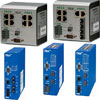

Contemporary Controls' managed switches now offer new features to better meet customers' requirements. These features are found on the company's EICP_M series, the EISX_M series, and the EISB_M B-Line series.
R&D manager for Contemporary Controls, Bennet Levine, says these features greatly enhance the effectiveness of these products in industrial networks. "These features are IGMP snooping, rate limiting, port security, and support for three types of quality of service (QoS) which are DiffServ, IEEE 802.1p, and TOS," explains Levine.
IGMP snooping is defined as the ability of a switch to observe Internet Group Management Protocol (IGMP) traffic in order to learn IP Multicast group membership for the purpose of restricting multicast transmissions to only those ports which have requested them. Levine says IGMP snooping is important in large EtherNet/IP networks.
"EtherNet/IP devices utilise multicast messages for their realtime data," says Levine. "However, on a switch that does not support IGMP snooping, these multicast messages will be handled like broadcast messages and potentially overwhelm some EtherNet/IP devices. Some devices may be unable to perform their normal activities when they receive a large amount of unwanted multicast traffic."
Rate limiting can be used to limit certain devices (or groups of devices connected to a port on the switch) from consuming too much network bandwidth. This feature is also useful when you interconnect the office network to the factory network.
"The port on the switch which connects to the office network can be given a low bandwidth setting," explains Levine. "This will keep traffic from the office network from upsetting the factory network as the office network cannot exceed the specified bandwidth limit setting. Rate limiting also allows broadcast storm protection to be enabled."
Levine says that when port security is enabled the switch will only pass traffic sent by specific devices. The MAC addresses of the allowed devices can be entered via the console port or via a Web page. This feature can be enabled on a port-by-port basis.
"This is a useful feature if extra security is required on specific ports of the switch," says Levine. "For example, if you wanted to only allow specific computers on the office network to be able to communicate with the factory network, you could enable port security on the port which connects to the office network."
As for QoS enhancements, he adds that they allow specific ports or specific messages to have a higher priority when communicating through the company's managed switch.
| Tel: | +27 12 493 0852 |
| Email: | [email protected] |
| www: | www.epd.co.za |
| Articles: | More information and articles about Electronic Products Design |
© Technews Publishing (Pty) Ltd | All Rights Reserved